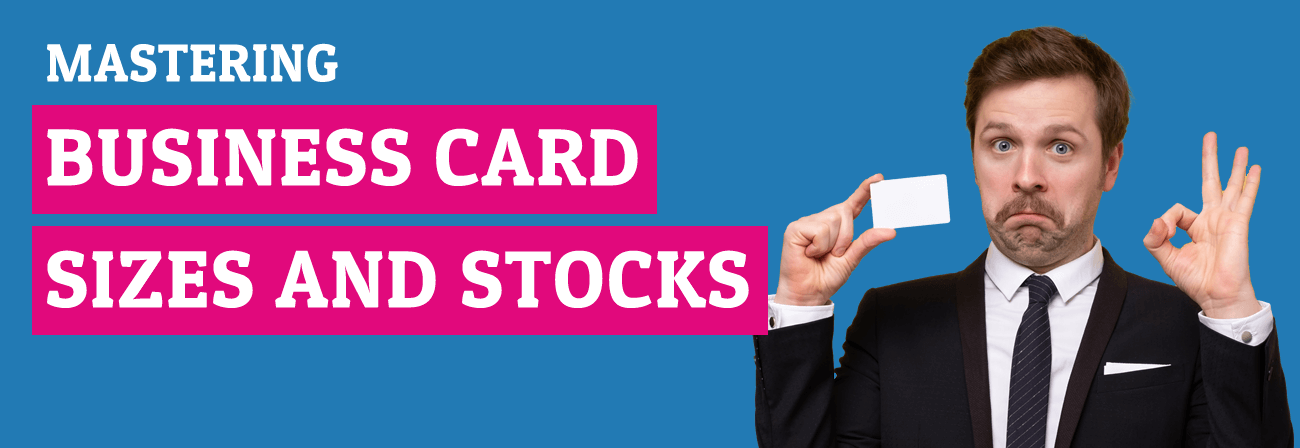Free nationwide shipping on all orders!
Simply, Affordable, Quality Print & Design in Staffordshire and the UK
Free nationwide shipping on all orders!
Simply, Affordable, Quality Print & Design in Staffordshire and the UK

We all know what business cards are, if we look in our phone case or wallet right now we are bound to find one. They have all the important contact information we need to hand that we were either given or that we wish to give to potential clients. In this ultimate guide, we will lead you through all the information you may need to consider about sizes and the best paper stock types available.
By the end of this, you will be able to make an informed decision regarding your amazing business cards.
In the United Kingdom, the Standard Business Card dimensions are 85mm x 55mm and this is generally considered the standard size for business cards. However, this doesn’t mean it’s the only size available; on the contrary, there are various sizes to choose from.
Finished dimensions of a UK Standard Business Card
This size is seen as the perfect way to showcase all your contact details, tagline and the other important elements of your design, whether you are having one-sided or two-sided business cards.
Finished dimensions of our Square Business Cards
Our Square business cards measure 55mm x 55mm finished. Perfectly formed and ideally suited for QR codes and your company’s logo! It is ideal for conveying a sense of creativity, innovation, and uniqueness, which can be particularly beneficial for businesses in creative industries.
Finished dimensions of our Slim Business Cards
Thin, Narrow or Mini, size Business Cards are a lot smaller than our larger business cards. The limited space on Mini business cards encourages a focus on essential information. This can be advantageous for conveying key details without overwhelming the recipient.
Certain industries or professions may find narrow business cards particularly suitable. For example, creative professionals, artists, or individuals in tech-related fields may appreciate the modern and unique appeal.
Folded business cards can be folded 2 ways to help you make the most of your folded business card design.
Flat dimensions of our Long Edge Folded Business Cards
Flat dimensions of our Short Edge Folded Business Cards
There are other units to measure design such as pixels however here at Print Stafford we would always recommend designing with mm in mind.
When it comes to choosing the cardstock for your business card there are a lot of options available and making the right paper choice can be dependent on your company’s products or services as well as your potential customers and clients. Like most printing companies we offer 350gsm paper or card business cards, typically we only use this in certain scenarios. 350gsm is ideally suited for cards that require an uncoated paper finish such as appointment cards or loyalty cards.
Usually with our standard business card printing services we would recommend a thicker 450gsm Silk Card as a starting point as it is less likely to bend and ensures that your business cards as well as your other marketing materials create that strong impression.
These are probably the most common business card weights however we do offer a lot more card stocks to help you make your card look different adding to its uniqueness and to help them resonate with your clients.
As part of our business card high-quality paper options, we offer Kraft as well as Silk, Uncoated and Creative Stocks.
Uncoated Stocks are ideal for loyalty cards or when you are going to write on the paper has a more natural grain and no coating at all.
| 350gsm Uncoated | This paper stock is ideal for projects where a classic, unrefined aesthetic is preferred. It is commonly used for items like loyalty cards, where writability is essential, and a more organic texture is desired. |
| 350gsm Uncoated 100% Recycled | The same as above made from recycled materials. |
Silk Stocks have a smoother silk coating applied, and most business cards tend to be printed on stock. As a rule of thumb, we typically print our cards on 450gsm as standard but can offer 350gsm Silk if needed.
| 350 gsm | Silky and smooth texture, enhancing the visual aesthetics of printed materials. |
| 450 gsm | Silky and smooth texture, enhancing the visual aesthetics of printed materials. |
Creative Stocks all have different finishes and textures bringing something different to the table, we would class Kraft stock as a creative stock. These stocks do tend to be more expensive due to the nature of these materials
| 235gsm Kraft | 235gsm Kraft is ideal for projects that aim to convey an eco-conscious or handmade aesthetic. |
| 270gsm Colorplan Bright White Stucco | This Colorplan Bright White Stucco stock is ideal for projects requiring a combination of elegance and texture. |
| 300gsm Accent Antique Magnolia | This paper stock is well-suited for projects that require a vintage or classic aesthetic. |
| 300gsm Kraft | This Kraft paper stock at 300gsm is well-suited for projects that seek a balance between durability and a rustic appearance. |
| 300gsm Metallic Ice Gold | This paper stock is ideal for projects requiring a touch of glamour and sophistication. |
| 300gsm Zeta Wove Cream | The smooth and wove texture enhances the paper’s tactile appeal, contributing to a premium feel. |
GSM refers to the thickness of the material within the print trade we wrote an article on this What Does GSM Mean in Printing?
Mastering the best card type for your business will depend on what they are being used for along with the look and aesthetic that you are trying to portray. Certain stocks have advantages over others and not every finish is available with all types of stocks due to production methods.
There are a wide range of finishing options including laminations such as Soft Touch, Matt and Glossy Lamination. With Matt and Soft-Touch you can offer a more tactile experience for your customers.
If you choose to use lamination with your business cards you can then choose to think about other luxury finishes such as foiling and Spot UV both offer a great way to make your cards stand out. Spot UV and foiling are suited to designs where this type of embellishment is used in a minimalistic yet professional manner.
When you choose to add additional finishing such as Spot UV or Foiling it can really make your business card design stand out to your potential customers giving that impression of high quality.
You may want to include rounded corners in your standard-sized business card printing, they are less likely to get bent or damaged compared to sharp corners. They offer a softer and more approachable look as well as looking modern and contemporary. For certain brands or businesses, rounded corners may align better with their brand image. It can be a deliberate design choice to match the overall brand aesthetics.
The choice is entirely up to you, when choosing your business card sizes and stock!
When considering the finishing and different printing options for your business cards, it’s essential to take a moment and evaluate whether the choice aligns with your brand image and the message you want to convey.
We are not going to cover the ins and outs of designing your business card here as we discussed this more in our article on How to design a business card. Where we cover the completely custom design aspects such as fonts, trim, CMYK and Adobe Photoshop.
We hope this article provided you with the information needed for you to make a decision on your company’s cost-effective business card size and stocks and finishes, which in turn will help you as part of the design process in understanding your printing needs.
Ready to bring your business cards to life? If you have any questions or need assistance with your printing needs, feel free to reach out to us. We’re here to turn your vision into a tangible, impactful reality.
